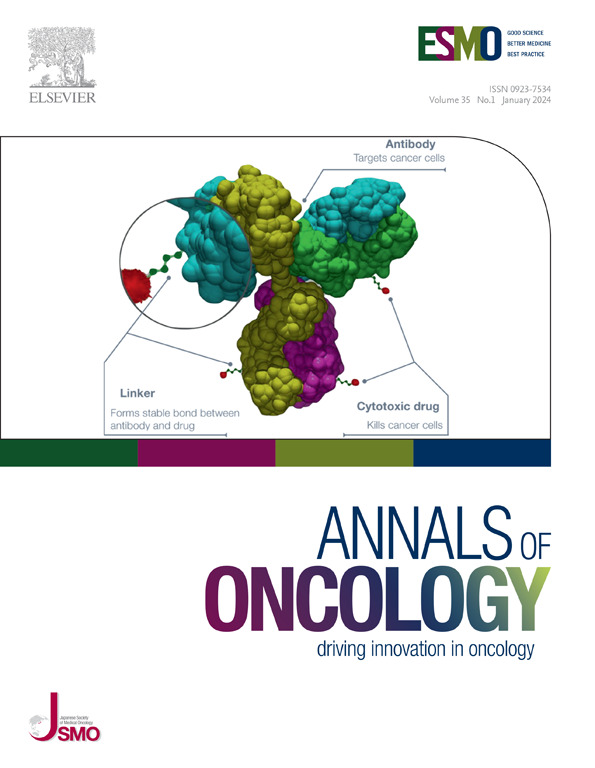A phase III randomised trial on the addition of a contact X-ray brachytherapy boost to standard neoadjuvant chemo-radiotherapy for organ preservation in early rectal adenocarcinoma: 5 year results of the OPERA trial
IF 56.7
1区 医学
Q1 ONCOLOGY
引用次数: 0
Abstract
Background
The OPERA trial has shown that a contact X-ray brachytherapy 50 kV (CXB) boost with neoadjuvant chemoradiotherapy (NCRT) can increase organ preservation (OP) rate for early rectal adenocarcinoma (ADK) of low-mid rectum. We report the results after 5 years of follow-up.
Patients and methods
OPERA was a multicentre, phase III trial that included operable patients (pts), with cT2-cT3b low-mid rectal ADK, tumours <5 cm, cN0 or cN1 <8 mm. All pts received external beam radiotherapy (EBRT): 45 Gy in 25 fractions with concurrent capecitabine. Pts were randomly assigned (1:1) to receive a boost of EBRT in group A (9 Gy/5 fractions) or a boost with CXB (90 Gy/3 fractions) in group B. The primary end point was OP rate.
Results
Out of 148 patients randomised, 141 were eligible. Between week 14-24, a clinical complete (or near) response was observed in 44 pts in group A (64%) versus 66 in group B (92%); P < 0.001. The 3-year OP rate was 59% in group A versus 81% in group B (P = 0.003). After update the median follow-up was 61.1 months [56.8-64.5]. The 5-year local regrowth was 39% in group A and 17% in group B (P = 0.1). The difference in OP was still highly significant between both groups: A 56% versus B 79% (P = 0.004). The difference was more significant if tumours <3 cm, with an OP rate of 93% in group B compared to 54% in group A. Of the 28 local regrowths, 3 occurred after 3 years of follow-up. Rectal bleeding (grade 1-2), which was the most prevalent toxicity during follow-up, disappeared most of the time after three years. Bowel function was not worsened by the CXB boost.
Conclusion
The OPERA trial was the first trial to demonstrate that CXB dose escalation was increasing the OP rate with good bowel function at 3 years. At 5 years, these results are sustained, especially in small early-stage tumours. The occurrence of some local regrowth after 3 years necessitates close surveillance of these pts during the 5-year period.
在早期直肠腺癌标准新辅助放化疗基础上增加接触式 X 射线近距离放射治疗以保留器官的 III 期随机试验:OPERA 试验的 5 年结果。
背景:OPERA试验表明,50kV接触式X线近距离放射治疗(CXB)联合新辅助化放疗(NCRT)可提高中低位早期直肠腺癌(ADK)的器官保留率(OP)。我们报告了随访5年后的结果:OPERA 是一项多中心 III 期试验,纳入了可手术的 cT2-cT3b 中低位直肠腺癌患者(pts):在随机抽取的 148 名患者中,有 141 名符合条件。在第 14-24 周,A 组有 44 名患者(64%)获得临床完全(或接近)反应,B 组有 66 名患者(92%)获得临床完全(或接近)反应:OPERA 试验是首个证明 CXB 剂量升级可提高 OP 率且 3 年后肠道功能良好的试验。5 年后,这些结果得以持续,尤其是对早期小肿瘤而言。由于 3 年后出现了一些局部再生现象,因此有必要在 5 年期间对这些患者进行密切监测。
本文章由计算机程序翻译,如有差异,请以英文原文为准。
求助全文
约1分钟内获得全文
求助全文
来源期刊

Annals of Oncology
医学-肿瘤学
CiteScore
63.90
自引率
1.00%
发文量
3712
审稿时长
2-3 weeks
期刊介绍:
Annals of Oncology, the official journal of the European Society for Medical Oncology and the Japanese Society of Medical Oncology, offers rapid and efficient peer-reviewed publications on innovative cancer treatments and translational research in oncology and precision medicine.
The journal primarily focuses on areas such as systemic anticancer therapy, with a specific emphasis on molecular targeted agents and new immune therapies. We also welcome randomized trials, including negative results, as well as top-level guidelines. Additionally, we encourage submissions in emerging fields that are crucial to personalized medicine, such as molecular pathology, bioinformatics, modern statistics, and biotechnologies. Manuscripts related to radiotherapy, surgery, and pediatrics will be considered if they demonstrate a clear interaction with any of the aforementioned fields or if they present groundbreaking findings.
Our international editorial board comprises renowned experts who are leaders in their respective fields. Through Annals of Oncology, we strive to provide the most effective communication on the dynamic and ever-evolving global oncology landscape.
 求助内容:
求助内容: 应助结果提醒方式:
应助结果提醒方式:


